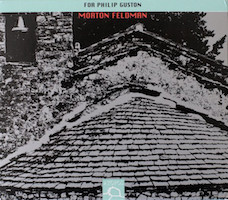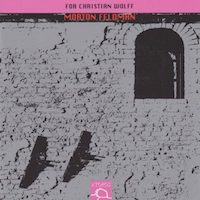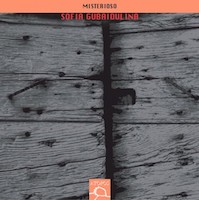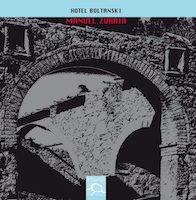Atopos Survey 4.
|
Grant Chu Covell [May 2018.] Atopos curates astonishing collections which must be sought out. Including this installment, we have covered everything that this unfamiliar label has released thus far.
Morton FELDMAN: For Philip Guston (1984). Carla Rees (fl), Simon Allen (perc), John Tilbury (pno). Atopos ATP 022-1-2-3-4 (4 CDs) (http://www.atoposmusic.com/). Scored for flute (alternating alto flute), percussion (glockenspiel, vibraphone, marimba, bells), and keyboard (piano, celesta), For Philip Guston is the most enormous mobile you will never see. The small instrumental universe changes subtly and infrequently. Bells appear long after you forget they are part of the arsenal. Piano and celesta interleave. Tilbury admits that in the excitement of performance he might inadvertently play the wrong keyboard. Late Feldman requires a leap of faith, or perhaps an intentional momentous lurch over a tricky threshold. Sometimes we listen to things if only to say, “I heard that,” as if the point of experiencing music is to arrive at the double bar and notch another mark. Feldman permits living within a work. Anyone can endure a four- or five-hour piece, played in the background while driving, folding laundry or perched alone in darkness. But fewer have the patience to discover moments as they unfold: A repeated two-note flute gesture out from under which the piano inches forward; the vibraphone climbs a few steps, retreats, starts all over again; the celesta’s grace notes which gently jar an imagined even pulse. This recording documents a performance at the Huddersfield Contemporary Music Festival on Nov. 21, 2012 (78:29 + 75:20 + 70:40 + 64:37 = 4:49:06). The trio is recorded modestly, in an unadorned manner that befits Feldman. Mallets are soft, the piano is quiet and closely captured. The slight audience noise reminds that this is live, that this is an experience just as much as it is delicate art. This trio takes the opus just slightly slower than Eberhard Blum, Nils Vigeland and Jan Williams, 4h 25m, on Hat ART CD 4-61041/2/3/4 (recorded August 1991). Apparently Rees had a terrible cold; however, there’s scant evidence.
Morton FELDMAN: For Christian Wolff (1986). Carla Rees (fl), John Tilbury (pno). Atopos ATP 025-1-2-3 (3 CDs) (http://www.atoposmusic.com/). In the airplane hangar which houses Feldman’s last works, For Christian Wolff may not be the longest, but it looms large. Perhaps it is the consistently high tessitura which creates a sensation of floating note clouds hovering just above. Flute and piano / celesta amble slowly for more than three hours. Often the pianist plays piano and celesta simultaneously. For example, at the opening, flute and piano can be heard alternating adjacent chromatic pitches, but quietly, hidden underneath, are the celesta’s tinsel peals. At this scale, Feldman encourages us to settle in, but then he toys with our expectations: Faster passages startle; the piano unexpectedly provides more than two notes at a time; the flute supplies a Webernian arc of unequal dissonant leaps; celesta notes ring out like flares. Or there will be oases where patterns of pitches rotate at slightly different speeds. On disc three, a passage occurs where flute and keyboard are separated by a mere whole-tone, and the gentle rocking in an unpredictable rhythm repeats in a manner that suggests a needle stuck in an LP groove. It is as if after so much solemnity, Feldman has hidden a joke. As Feldman’s late pieces go, this one appears harder to discuss because it’s unglamorous and introspective. It makes for a forlorn road trip. The composer himself considered it severe. Atopos’ live recording was caught in Osterfestival Hall in Tirol, Innsbruck, Austria, on March 16, 2016 (69:17 + 60:43 + 69:85 = 3:19:00). As with Philip Guston, perhaps Rees and Tilbury have found a slower center for Feldman: The California EAR Unit recording on Bridge 9279A/C with Dorothy Stone and Vicki Ray is slightly faster (60:08 + 54:59 + 61:42 = 2:56:49; recorded November 2005).
“Misterioso.” Sofia GUBAIDULINA: Jubilatio (1979)1; In the beginning there was rhythm (1984)2; Pari e dispari (1991)3; Misterioso (1977)4; Detto I (1980)5; Quasi Hoquetus (1984)6; Five Etudes (1965)7; Ritorno perpetuo (1997)8; Toccata-Troncata (1971)9; Invention (1974)10; Garten von Freuden und Traurigkeiten (1980)11. I percussionisti dell’Istituto Pietro Mascagni di Livorno1,2,3,4: Samuel Baldi, Tommaso Ferrieri Caputi, Giacomo Putrino, Mario Lai, Matteo Lenzi, Fabio Macchiavelli, Giacomo Cirinei (perc), Chiara Tiboni3,8 (hpsi), Edy Bodecchi5 (org), Massimo Ceccarelli6,7 (cbs), Maurizio Paciariello6,9,10 (pno), Luca Sanzò6,11 (vla), Lucia Bova7,11 (hp), Antonio Caggiano7 (perc), Manuel Zurria11 (fl), Philippe Daverio11 (speaker), Jonathan Faralli1,2,3,4,5 (perc, cond.). Atopos ATP 023-24 (2 CDs) (http://www.atoposmusic.com/). Atopos collects recordings from three concerts (in 2014 and 2015), including premiere releases, that offer a fantastic combination of Gubaidulina’s inscrutable riddles and messages. This music defies familiar forms and ensembles. There are two discs here (70:07 + 68:54). Side one introduces percussion ensembles that might announce rituals. The constrained Jubilatio cordons off a part of the Varèsian jungle; the cimbalom is unexpected amongst drums and chimes. Also subdued, In the beginning there was rhythm invokes its universe according to a hidden numeric scheme. The instrumentation expands from timpani to drums then unexpectedly to glockenspiel and marimbas. Pari e dispari is also gentle and arcane with percussion and the tang of harpsichord. Reflecting its title, “Even and Uneven” is more random than Jubilatio’s orderliness. An earlier piece, Misterioso includes the whine of bowed cymbals alongside timpani and pitched percussion (vibraphone, marimba). The organ and percussion duet, Detto I, with clusters and ponderous, lumbering gestures has the gravity and crankiness which might be more familiar to a Gubaidulina follower. The percussion ensembles, for four, seven, eight and seven players respectively, are not large pieces with loud events, but expansive works that push action across distances into corners. There is distant applause at the first CD’s end. The second disc offers slightly more familiar chamber music combinations, including the set closer, Garten von Freuden und Traurigkeiten. Quasi Hoquetus opens with a melodic piano tocsin, a cross between birdsong and an interrupting cell phone. A big, rambling sonata for viola, double bass (or bassoon) and piano includes multiple stylistic references (jazz, common practice harmony, etc.) and is organized using numerical series and patterns (Fibonacci, etc.). The Five Etudes are also for an unusual trio: harp, double bass and piano. Jazz pervades the collection, overtly in No. 2, elsewhere in the percussion choices and the atonal walking bass. The series requires aligning tricky cross rhythms. I can imagine this was a big deal in 1965 Soviet lands. Ritorno perpetuo, originally written for Chojnacka, vividly executed here by Chiara Tiboni, stands at nearly a quarter hour. It is a tenacious swathe, the harpsichord ruminating across idle lines, tightly spaced chords, and the subtle differences in timbres between two manuals. The brief Toccata-Troncata erupts in equal parts rapid passages and silence. As the work proceeds, it sputters as if a repeating pattern has been diligently erased. Similarly, the less than single-minute Invention abruptly halts its rapid-fire pace. The Garten von Freuden und Traurigkeiten for flute, viola, harp and speaker (text by Francisco Tanzer) is a big single movement. Other than the jazz twinges in the Etudes, this work is the most evocative. The flute, harp and viola combination recalls French works, and specific harp flourishes and trilling flute suggest something Oriental. The narrator appears at the end with a few words before audience applause.
“Hotel Boltanski.” György KURTÁG: Virág az ember… (1983)1; Virág az ember, mijakónak (2001)2. Salvatore SCIARRINO: Autostrada prima di Babilonia (2015)3; Come vengono prodotti gli incantesimi? (1985)4. Beat FURRER: Invocation VI (2007)5. Heinz HOLLIGER: Pour Roland Cavin (2005)6. Toshio HOSOKAWA: Sen I (1984)7. Yan MARESZ: Circumambulation (1997)8. Peter ABLINGER: Ohne titel / three flutes (1989-91)9. Noah CRESHEVSKY: Psalmus XXIII (2016)10. Howard SKEMPTON: Half moon (1990)11; Axis 90 (1990)12. Mary Jane LEACH: Bruchstück (2002)13. Michel VAN DER AA: Rekindle (2010)14. Laurence CRANE: Four Pieces (1995)15. Giuliano D’ANGIOLINI: Berceuse (2013)16; Romanza (alla memoria di Franz Schubert, alle armonie sparse del suo Adagio) (2016)17. Pierre JODLOWSKI: Limite Circulaire (2011)18. Manuel Zurria1,2,3,4,5,6,7,8,9,10,11,12,13,14,15,16,17,18 (fl), Giulia Peri5, Beth Griffith10 (sop), Howard Skempton11 (acc), Mark Knoop12, Giuliano D’Angiolini17 (pno). Atopos ATP 026-27 (2 CDs) (http://www.atoposmusic.com/). Among this two-disc omnibus of flute music (76:24 + 77:34) are multi-tracked flutes and works for flute and tape. Half of the 18 pieces are premiere recordings. This collection is a tribute to the artist Christian Boltanski and we are asked to consider this release a “small museum of wonders,” or a Wunderkammer. Zurria is no stranger to such productions. A hard-to-find three-disc collection, Repeat!, on Die Schachtel (DSZC1) from 2007, contains Ferrari, Feldman, Lucier, Clementi, Scodanibbio, et al. (Zurria also contributes to the Gubaidulina release in Garten von Freuden und Traurigkeiten.) We begin with two short and curious Kurtág items arranged for flute choir (“Flowers we are”) which center upon open fifths. Several works stick to traditional means. Besides the Kurtág, these include Holliger’s two-page trio (piccolo, flute, alto flute), recorded at a distance for an unusually antique sound (the score indicates 2005, not 2004 as per here), and Crane’s Four which camp at the bottom end of the flute spectrum, suggesting tonal music that doesn’t want to behave as expected. The score indicates two alto flutes and two bass flutes, but sometimes the bass pair doubles the same line. Crane’s collection is simple music, but it gets under the skin. Like a door forced open by desert wind, the air blasts Sciarrino asks for create an uninviting landscape in Autostrada prima di Babilonia. The earlier work steps beyond the Magic Flute, asking “How are the spells produced?” Hosokawa’s piece is scored for flute alone (“with much tension”), but here Zurria adds taped temple bells which balloon into an encroaching hum. Invocation VI is Scene VI from Furrer’s opera Invocation. We hear an active percussive flute under staccato syllables which on first encounter could be Aperghis. Texts are in Spanish (the opera leverages Marguerite Duras, Ovid and Pavese). In Creshevsky’s eccentric Psalm the flute courses over a synthetic organ and chopped up vocal bits. All taped sounds derive from soprano Griffith’s voice; when slowed and pitched lower, the sighs and syllables are peculiarly creepy. Skempton’s brief duos, Half moon for flute and accordion (1:43), and Axis 90 for flute and piano (2:08), are momentary palate cleansers. D’Angiolini contributes a curious pair: In Berceuse, a flute comments over distributed percussive copies (five players total), and Schubert hides in the unhurried Romanza as a piano plucks out chord remnants. Ablinger’s Ohne titel / three flutes leverages specific extensions (metal tubes which fit into the flute) that divide the octave into 13 equal parts for the second player, and into 15 for the third. The trio slithers in close harmony, meandering like coarse canons for 23 minutes. Each disc closes with an anchor. On disc one it’s Ablinger’s three microtonal flutes; on disc two, Jodlowski’s Limite Circulaire for flute and tape is a gentle throwback to late 20th instrument-plus-tape pieces, inspired by Escher’s print as well as looping techniques. As with any varied offering, some elements recede to the edges. Despite the astonishing difficulty required for Maresz’s Circumambulation, which requires a constant repeated note from which all activity springs, the totality doesn’t impress. Leach’s slowly unfolding sextet Bruchstück might be a process piece for multiple flutes with intentional or inadvertent late-19th-century gesticulations. Van der Aa’s percussive tape under flute noodling didn’t seem to arrive, even though the player reacts to the tape.
Ablinger, Crane, Creshevsky, D'Angiolini, Feldman, Furrer, Gubaidulina, Holliger, Hosokawa, Jodlowski, Kurtág, Maresz, MJ Leach, Sciarrino, Skempton, Van der Aa
[More Atopos, Grant Chu Covell]
[More
Ablinger, Crane, Creshevsky, D'Angiolini, Feldman, Furrer, Gubaidulina, Holliger, Hosokawa, Jodlowski, Kurtág, Maresz, MJ Leach, Sciarrino, Skempton, Van der Aa]
[Previous Article:
Armchair Operas and Amusements 14.]
[Next Article:
Giuoco delle coppie]
|



